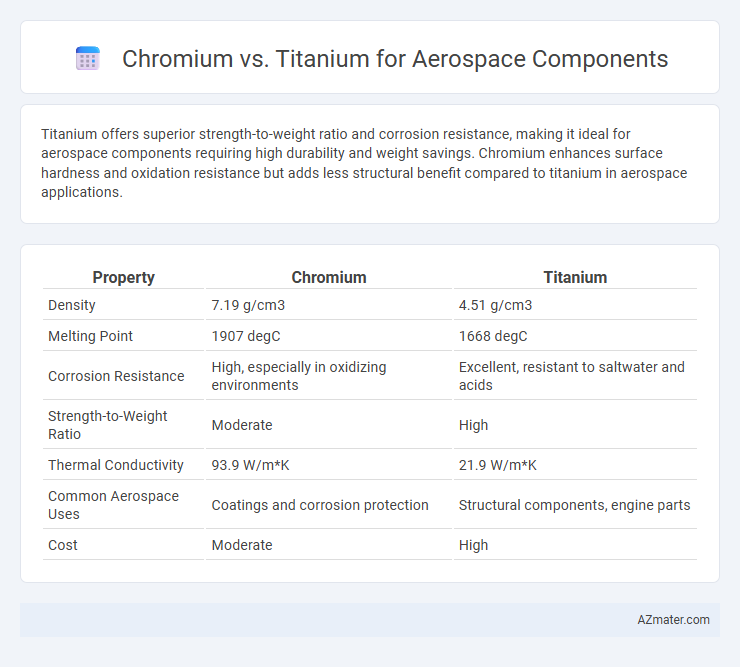Titanium offers superior strength-to-weight ratio and corrosion resistance, making it ideal for aerospace components requiring high durability and weight savings. Chromium enhances surface hardness and oxidation resistance but adds less structural benefit compared to titanium in aerospace applications.
Table of Comparison
| Property | Chromium | Titanium |
|---|---|---|
| Density | 7.19 g/cm3 | 4.51 g/cm3 |
| Melting Point | 1907 degC | 1668 degC |
| Corrosion Resistance | High, especially in oxidizing environments | Excellent, resistant to saltwater and acids |
| Strength-to-Weight Ratio | Moderate | High |
| Thermal Conductivity | 93.9 W/m*K | 21.9 W/m*K |
| Common Aerospace Uses | Coatings and corrosion protection | Structural components, engine parts |
| Cost | Moderate | High |
Introduction to Chromium and Titanium in Aerospace
Chromium and titanium are critical materials in aerospace engineering due to their exceptional strength-to-weight ratios and corrosion resistance. Chromium is primarily used as an alloying element to enhance hardness and oxidation resistance in aerospace steels and superalloys. Titanium offers superior strength, low density, and excellent resistance to extreme temperatures, making it ideal for structural components and engine parts in high-performance aircraft.
Material Properties: Strength and Weight Comparison
Chromium offers high hardness and excellent corrosion resistance, but its density of 7.19 g/cm3 makes it heavier compared to titanium, which has a lower density of 4.51 g/cm3, providing significant weight savings in aerospace applications. Titanium alloys exhibit superior strength-to-weight ratios, combining tensile strength exceeding 900 MPa with lighter weight, critical for improving fuel efficiency and performance. The distinct advantage of titanium in aerospace components lies in its balance of high strength, low density, and corrosion resistance, making it the preferred choice over chromium-based materials.
Corrosion Resistance: Chromium vs Titanium
Titanium exhibits superior corrosion resistance compared to chromium, especially in aerospace environments exposed to saltwater and high humidity. Chromium enhances corrosion resistance primarily when used as a plating or alloying element, providing a protective oxide layer that prevents surface degradation. The inherent ability of titanium to form a stable, self-healing oxide film makes it highly resistant to oxidation, pitting, and stress corrosion cracking, crucial for aerospace component longevity.
Temperature Tolerance and Performance
Chromium alloys exhibit high-temperature tolerance up to 1,000degC, making them suitable for components exposed to extreme heat in aerospace engines. Titanium alloys offer exceptional strength-to-weight ratios and maintain mechanical integrity at temperatures up to 600degC, optimizing performance in airframe and structural parts. The choice between chromium and titanium depends on specific temperature requirements and weight considerations in aerospace applications.
Manufacturability and Machining Differences
Chromium offers high hardness and corrosion resistance, making it challenging to machine due to tool wear and lower machinability ratings, often requiring specialized cutting tools and slower machining speeds. Titanium, favored in aerospace for its strength-to-weight ratio, exhibits poor thermal conductivity, leading to heat buildup during machining and necessitating optimized cutting parameters and advanced cooling techniques to prevent work hardening and tool failure. The manufacturability of chromium alloys typically involves more complex processes and higher tooling costs compared to titanium, which, despite machining difficulties, benefits from greater availability of aerospace-grade alloys and established fabrication methods.
Cost Analysis: Chromium vs Titanium Components
Titanium components in aerospace generally incur higher manufacturing and material costs compared to chromium due to titanium's superior strength-to-weight ratio and corrosion resistance. Chromium offers a more cost-effective alternative for wear-resistant parts but may require additional coatings or treatments to match titanium's durability, increasing overall expenses. The selection hinges on balancing initial material costs against long-term performance and maintenance savings in aerospace applications.
Suitability for Structural Applications
Chromium offers excellent corrosion resistance and hardness, making it suitable for aerospace components exposed to harsh environments but less ideal for load-bearing structural parts due to its brittleness. Titanium provides a superior strength-to-weight ratio and exceptional fatigue resistance, making it highly suitable for aerospace structural applications that demand high performance under stress. Its ability to withstand extreme temperatures and resist corrosion enhances the longevity and safety of critical aerospace structures.
Fatigue Life and Durability in Aerospace Conditions
Titanium alloys exhibit superior fatigue life and corrosion resistance compared to chromium-based materials, making them ideal for aerospace components exposed to cyclic stress and harsh environments. Chromium coatings enhance surface hardness and wear resistance but generally do not match titanium's overall durability under prolonged fatigue loading in aerospace conditions. The exceptional strength-to-weight ratio of titanium alloys contributes to improved fatigue performance and longevity in aircraft structures subjected to variable stress and temperature fluctuations.
Sustainability and Environmental Impact
Chromium offers excellent corrosion resistance and recyclability, reducing environmental waste in aerospace manufacturing, while titanium's superior strength-to-weight ratio enables fuel efficiency and lower carbon emissions during flight. Titanium production demands significantly higher energy input compared to chromium, leading to a larger initial carbon footprint, yet its long-term operational benefits often outweigh this impact. Sustainable aerospace design increasingly favors titanium for performance benefits, but chromium's lower energy manufacturing process makes it a valuable material for components where weight is less critical.
Future Trends in Aerospace Material Selection
Chromium and titanium both play crucial roles in aerospace component fabrication due to their unique properties, but future trends indicate a growing preference for titanium alloys because of their superior strength-to-weight ratio and corrosion resistance. Advancements in additive manufacturing and material science are enabling more efficient production of titanium components with enhanced performance characteristics, further driving its adoption in next-generation aerospace designs. Research into hybrid composites integrating titanium with other high-performance materials suggests continued innovation aimed at optimizing durability, weight reduction, and fuel efficiency in aerospace applications.

Infographic: Chromium vs Titanium for Aerospace Component
 azmater.com
azmater.com